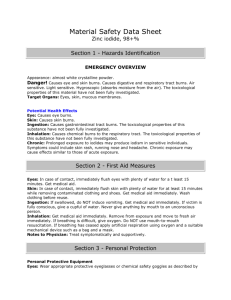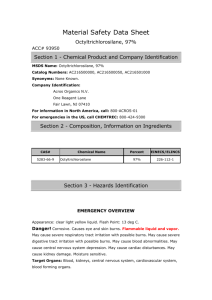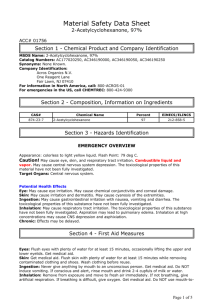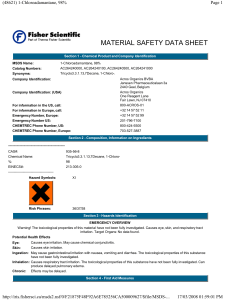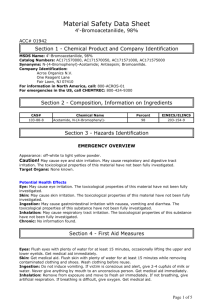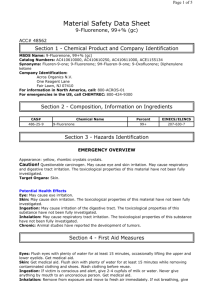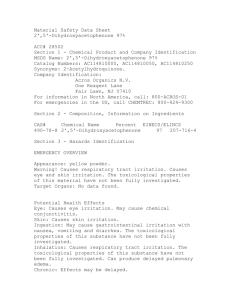MATERIAL SAFETY DATA SHEET - Sisco Research Laboratories
advertisement
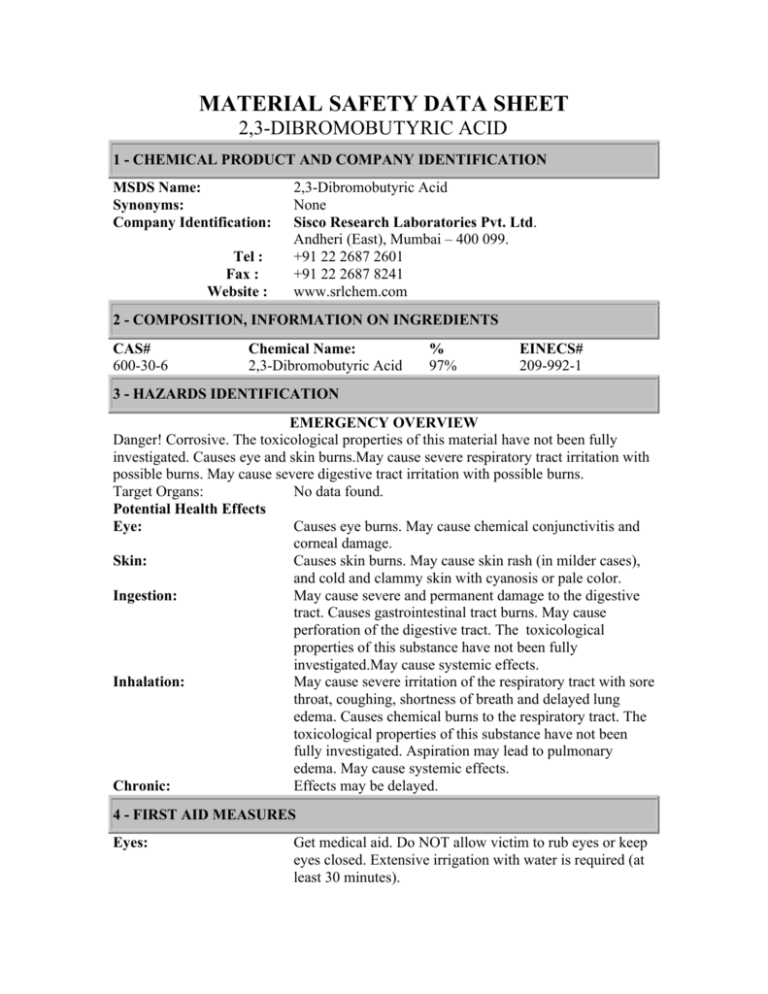
MATERIAL SAFETY DATA SHEET Section 1 2,3-DIBROMOBUTYRIC ACID 1 - CHEMICAL PRODUCT AND COMPANY IDENTIFICATION MSDS Name: Synonyms: Company Identification: Tel : Fax : Website : 2,3-Dibromobutyric Acid None Sisco Research Laboratories Pvt. Ltd. Andheri (East), Mumbai – 400 099. +91 22 2687 2601 +91 22 2687 8241 www.srlchem.com 2 - COMPOSITION, INFORMATION ON INGREDIENTS CAS# 600-30-6 Chemical Name: 2,3-Dibromobutyric Acid % 97% EINECS# 209-992-1 3 - HAZARDS IDENTIFICATION EMERGENCY OVERVIEW Danger! Corrosive. The toxicological properties of this material have not been fully investigated. Causes eye and skin burns.May cause severe respiratory tract irritation with possible burns. May cause severe digestive tract irritation with possible burns. Target Organs: No data found. Potential Health Effects Causes eye burns. May cause chemical conjunctivitis and Eye: corneal damage. Skin: Causes skin burns. May cause skin rash (in milder cases), and cold and clammy skin with cyanosis or pale color. Ingestion: May cause severe and permanent damage to the digestive tract. Causes gastrointestinal tract burns. May cause perforation of the digestive tract. The toxicological properties of this substance have not been fully investigated.May cause systemic effects. Inhalation: May cause severe irritation of the respiratory tract with sore throat, coughing, shortness of breath and delayed lung edema. Causes chemical burns to the respiratory tract. The toxicological properties of this substance have not been fully investigated. Aspiration may lead to pulmonary edema. May cause systemic effects. Chronic: Effects may be delayed. 4 - FIRST AID MEASURES Eyes: Get medical aid. Do NOT allow victim to rub eyes or keep eyes closed. Extensive irrigation with water is required (at least 30 minutes). Skin: Ingestion: Inhalation: Get medical aid immediately. Immediately flush skin with plenty of water for at least 15 minutes while removing contaminated clothing and shoes. Wash clothing before reuse. Destroy contaminated shoes. Never give anything by mouth to an unconscious person. Get medical aid. Do NOT induce vomiting. If conscious and alert, rinse mouth and drink 2-4 cupfuls of milk or water. Remove from exposure and move to fresh air immediately. If not breathing, give artificial respiration. If breathing is difficult, give oxygen. Get medical aid. Do NOT use mouth-to-mouth resuscitation. If breathing has ceased apply artificial respiration using oxygen and a suitable mechanical device such as a bag and a mask. Notes to Physician: 5 - FIRE FIGHTING MEASURES General Information: Extinguishing Media: As in any fire, wear a self-contained breathing apparatus in pressure-demand, MSHA/NIOSH (approved or equivalent), and full protective gear. During a fire, irritating and highly toxic gases may be generated by thermal decomposition or combustion. Use water spray to keep fire-exposed containers cool. Contact with metals may evolve flammable hydrogen gas. Containers may explode when heated. Noncombustible, substance itself does not burn but may decompose upon heating to produce irritating, corrosive and/or toxic fumes. Do NOT get water inside containers. For small fires, use dry chemical, carbon dioxide, or water spray. For large fires, use dry chemical, carbon dioxide, alcohol-resistant foam, or water spray. Cool containers with flooding quantities of water until well after fire is out. 6 - ACCIDENTAL RELEASE MEASURES General Information: Spills/Leaks: Use proper personal protective equipment as indicated in Section 8. Vacuum or sweep up material and place into a suitable disposal container. Clean up spills immediately, observing precautions in the Protective Equipment section. Avoid generating dusty conditions. Provide ventilation. 7 – HANDLING AND STORAGE Handling: Wash thoroughly after handling. Use with adequate ventilation. Minimize dust generation and accumulation. Avoid contact with eyes, skin, and clothing. Do not breathe Storage: dust, mist, or vapor. Keep container tightly closed. Avoid ingestion and inhalation. Discard contaminated shoes. Store in a tightly closed container. Store in a cool, dry, well-ventilated area away from incompatible substances.Corrosives area. 8 – EXPOSURE CONTROLS, PERSONAL PROTECTION Engineering Controls: Not available Exposure Limits Personal Protective Equipment Eyes: Wear appropriate protective eyeglasses or chemical safety goggles as described by OSHA's eye and face protection regulations in 29 CFR 1910.133 or European Standard EN166. Skin: Wear appropriate protective gloves to prevent skin exposure. Clothing: Wear appropriate protective clothing to prevent skin exposure. Respirators: A respiratory protection program that meets OSHA's 29 CFR 1910.134 and ANSI Z88.2 requirements or European Standard EN 149 must be followed whenever workplace conditions warrant respirator use. 9 - PHYSICAL AND CHEMICAL PROPERTIES Physical State: Melting Point: Molecular Formula: Molecular Weight: Solid 86- 87 deg C C4H6Br2O2 245.91 10 - STABILITY AND REACTIVITY Chemical Stability: Stable at room temperature in closed containers under normal storage and handling conditions. Incompatible materials, dust generation, excess heat. Conditions to Avoid: Incompatibilities with Other Materials : Not available Hazardous Decomposition Products : Carbon monoxide, irritating and toxic fumes and gases, carbon dioxide, hydrogen bromide. Hazardous Polymerization : Has not been reported. 11 - TOXICOLOGICAL INFORMATION RTECS#: LD50/LC50: Carcinogenicity: CAS# 600-30-6: None listed RTECS: Not available. 2,3-Dibromobutyric Acid - Not listed as a carcinogen by ACGIH, IARC, NTP, or CA Prop 65. Other: Not available 12 - ECOLOGICAL INFORMATION Not available 13 - DISPOSAL CONSIDERATIONS Not available 14 - TRANSPORT INFORMATION Shipping Name: Hazard Class: UN Number: Packing Group: IATA Corrosive Solid, Acidic, Organic, N.O.S. 8 3261 III IMO Corrosive Solid, Acidic, Organic, N.O.S. 8 3261 III RID/ADR Corrosive Solid, Acidic, Organic, N.O.S. 8 3261 III 15 - REGULATORY INFORMATION European/International Regulations European Labeling in Accordance with EC Directives Hazard Symbols: C Risk Phrases: R 34 Causes burns. Safety Phrases: S 26 In case of contact with eyes, rinse immediately with plenty of water and seek medical advice.S 28A After contact with skin, wash immediately with plenty of water.S 37 Wear suitable gloves.S 45 In case of accident or if you feel unwell, seek medical advice immediately (show the label where possible). WGK (Water Danger/Protection)CAS# 600-30-6: Not available US Federal TSCA CAS# 600-30-6 is not listed on the TSCA Inventory. It is for research and development use only. Health & Safety Reporting List None of the chemicals are on the Health & Safety Reporting List. Chemical Test Rules None of the chemicals in this product are under a Chemical Test Rule. Section 12b None of the chemicals are listed under TSCA Section 12b. TSCA Significant New Use Rule None of the chemicals in this material have a SNUR under TSCA. CERCLA Hazardous Substances and corresponding RQs None of the chemicals in this material have an RQ. SARA Section 302 Extremely Hazardous Substances Section 313 Clean Air Act: Clean Water Act: OSHA: California Prop 65 Risk Level: None of the chemicals in this product have a TPQ. No chemicals are reportable under Section 313. This material does not contain any hazardous air pollutants. This material does not contain any Class 1 Ozone depletors. This material does not contain any Class 2 Ozone depletors. None of the chemicals in this product are listed as Hazardous Substances under the CWA.None of the chemicals in this product are listed as Priority Pollutants under the CWA. None of the chemicals in this product are listed as Toxic Pollutants under the CWA. STATE 2,3-Dibromobutyric Acid is not present on state lists from CA, PA, MN, MA, FL, or NJ. California No Significant None of the chemicals in this product are listed.6 16 - ADDITIONAL INFORMATION SISCO RESEARCH LABORATORIES provides the information contained herein in good faith but makes no representation as to its comprehensiveness or accuracy. This document is intended only as a guide to the appropriate precautionary handling of the material by a properly trained person using this product. Individuals receiving the information must exercise their independent judgment in determining its appropriateness for a particular purpose.

